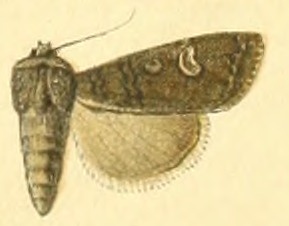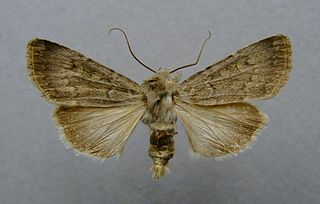
The garden dart is a moth of the family Noctuidae. It is distributed throughout much of the Palearctic. Temperate regions of Europe, Central Asia and North Asia, as well as the mountains of North Africa. Absent from polar regions, on Iceland and some Mediterranean islands, as well as in Macaronesia.

Euxoa nigrofusca, the white-line dart, is a moth of the family Noctuidae. It is found from Europe, to southern Siberia, central Asia to the Pacific Ocean. In North Africa it is known from Morocco and Algeria.

Euxoa obelisca, the square-spot dart, is a moth of the family Noctuidae. It is found in the Palearctic realm.

Euxoa is a genus of moths of the family Noctuidae raised to Genus by the German entomologist, Jacob Hübner. The Genus is mostly confined to dry and semi dry areas in the Northern Hemisphere. There 130 species in Eurasia, a few in Africa, and 175 in North America. There are no species in the Genus in South-East Asia or in Australia. In North America, most species are found in Western regions. Of the North American species, 4 are endemic to Mexico. There is one species recorded from Chile, but this may be a mislabeled specimen. In real terms, species numbers do not equal species abundance. Some areas with few species have large numbers of the ones that do live there.

Euxoa cursoria, the coast dart, is a moth of the family Noctuidae. It is found in northern and central Europe as well as the coastal regions of the British Isles, central Siberia, Mongolia, Tibet and Afghanistan. The subspecies Euxoa cursoria wirima is found in Canada.

Euxoa recussa is a moth of the family Noctuidae. The nominate form is found in mountainous areas in Southern Europe as well as the Alps. Euxoa recussa tetrastigma is found Northern Europe, east to Russia, Western Siberia, the Altai Mountains and Amur.

Euxoa catenula is a species of moth of the family Noctuidae first described by Augustus Radcliffe Grote in 1879. It is found in North America from southern Saskatchewan west to southern Vancouver Island, south to Kansas, New Mexico, Arizona and southern California.

Euxoa distinguenda is a moth of the family Noctuidae. It is found in central, southern and eastern Europe, Turkey, Lebanon, Israel, Jordan and western Asia.

Euxoa cos is a moth of the family Noctuidae. It is found in southern Europe, the Near East and Middle East.

Euxoa adumbrata, the sordid dart, is a moth of the family Noctuidae. The species was first described by Eduard Friedrich Eversmann in 1842. In North America it is found across northern Canada from Quebec to western Alaska, south to the northern parts of the United States, and in the mountains to Colorado. It is also found in Greenland, the coastal areas of Scandinavia and the Ural. It was recently recorded from Denmark, although this includes Euxoa lidia, which some authors regard to be a valid species.
Euxoa aequalis is a moth of the family Noctuidae first described by Leon F. Harvey in 1876. It is found in Canada from British Columbia, Alberta, Saskatchewan and Yukon, south into the United States, where it has been recorded from Colorado, Wyoming and California.
Euxoa basalis is a moth of the family Noctuidae. It is found in Alberta, Saskatchewan and the Northern Territories in Canada, south to Colorado, Arizona and California. It is abundant in the Rocky Mountain region.

Euxoa comosa, the hairy euxoa moth, is a moth of the family Noctuidae first described by Herbert Knowles Morrison in 1876. It is found in western North America, except the Pacific coast, ranging east through the northern Great Plains, and in the Hudsonian zone to the Atlantic Ocean. It is found in every province and territory of Canada, except Nunavut.

Euxoa nyctopis is a moth of the family Noctuidae. It is found in north-western India.

Euxoa eruta is a moth of the family Noctuidae. It is found in Italy, Spain, France, Germany, Denmark, Fennoscandia, Austria, Switzerland, Hungary, Bulgaria, the Czech Republic, Greece, Turkey, Belarus, the Baltic region, Siberia and from central Asia up to the Altai Mountains. Note that E. eruta may not be a good species. The Euxoa tritici complex consists of five sibling species in Europe: Euxoa tritici, Euxoa nigrofusca, Euxoa eruta, Euxoa diaphora Boursin, 1928 and Euxoa segnilis. Furthermore, although Fibiger (1997) treated Euxoa montivaga differently it belongs to the E. tritici complex. Differences among the species are subtle, the most important diagnostic characteristics being genitalic. In studies of three of these species, E. tritici, E. nigrofusca and E. eruta, no support was found for the presence of several morphologically distinguishable species with quantitative morphometric analyses.

Euxoa aquilina is a moth of the family Noctuidae. It is found in the Mediterranean region of Europe, North Africa, the Near East and the Middle East.

Euxoa decora is a moth of the family Noctuidae. It is found in southern and central Europe, Morocco, Algeria, the Caucasus, Armenia, Issyk-Kul, Turkey, Iran and Iraq.

Euxoa hastifera is a moth of the family Noctuidae. It is found from southern Europe to Siberia and Tajikistan.

Euxoa ochrogaster, the red-backed cutworm, is a moth of the family Noctuidae. It is found from Iceland and northern Europe, through the Baltic to the Amur region. In North America, it is found from Alaska to Newfoundland and Labrador, south into the northern part of the United States, south in Rocky Mountains to Arizona and New Mexico.
















